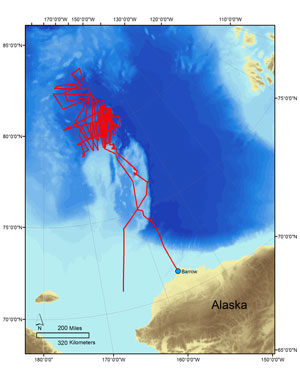 ©2020 Biological and Chemical Oceanography Data Management Office.
©2020 Biological and Chemical Oceanography Data Management Office.Funded by the U.S. National Science Foundation
Extracted from the NSF award abstract:
The proposed research aims to identify mechanisms of ocean acidification and carbonate undersaturation in the Canada Basin of the Arctic Ocean. The investigators will use a 3-year dataset to address the role of two specific mechanisms involving sea-ice processes: (1) surface water freshening and undersaturation resulting from recent enhanced melting of multi-year sea-ice, and (2) surface water undersaturation resulting from a "carbon-pumping" mechanism driven by brine rejection and carbonate mineral precipitation during increasingly cyclical seasonal sea ice growth and decay. The proposed work would expand understanding of the inorganic carbon cycle, air-sea CO2 exchange rates and acidification in the Arctic Ocean. Understanding baselines and how they are changing is important for setting realistic parameters for process studies on the effects of ocean acidification on flora and fauna.
Models project the Arctic Ocean will become undersaturated with respect to carbonate minerals in the next decade. Recent field results indicate parts may already be undersaturated in late summer months when ice melt is at its greatest extent. However, few comprehensive datasets of carbonate system parameters in the Arctic Ocean exist. Researchers from the U.S. Geological Survey (USGS) and University of South Florida (USF) collected high-resolution measurements of pCO2, pH, total dissolved inorganic carbon (DIC), total alkalinity (TA), and carbonate (CO3-2) from the Canada Basin that fill critical information gaps concerning Arctic carbon variability. A Multiparameter Inorganic Carbon Analyzer (MICA) was used to collect approximately 1,800 measurements of pH and DIC along an 11,965-km trackline in August and September 2012. In addition, over 500 discrete surface water samples were taken. These data are being used to characterize and model regional pCO2, pH, and carbonate mineral saturation state. A high-resolution, three-dimensional map of these results will be presented.
Data collected on the August 2012 Arctic Cruise will be used to create regional maps of seawater carbonate parameters, including pCO2 flux/change maps, and derivative maps on saturation state. Maps depicting pCO2 and carbonate saturation states over large latitudinal and nearshore to offshore gradients are needed for the Arctic, where significant decline of carbonate ecosystems, habitats, and calcifying organisms are predicted over the next decade. The data will allow the USGS to map variations in ocean chemistry along designated tracks and will be used in models to predict future Arctic Ocean saturation states.
Note: Jonathan Wynn is a former Pricipal Investigator for this project

Principal Investigator: Dr Bogdan Onac
University of South Florida (USF)
Principal Investigator: Dr Jonathan Wynn
University of South Florida (USF)
Co-Principal Investigator: Dr Lisa Robbins
United States Geological Survey (USGS)
OA - Canada Basin Data Management Plan (77.48 KB)
09/17/2014